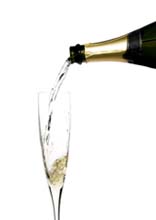Choose your sparkling wine!
Pop! goes the champagne (or Cava, or Prosecco) cork and cheers to the New Year! Sayonara 2014! As you clink together your glass of….Champagne? Prosecco? Sparkling wine? Cava? (Dare I say fizzy Rose?)...well, what will it be? That's just it - there are many different types of sparkling wine that will be used to hustle in 2015! So what will you choose? Here's a little breakdown of the differences!
Champagne, Prosecco, Cava, what’s in a name? Isn’t it all just sparkling wine? Well yes and no. Each of those different wines are defined by grape varietals, taste, price point and location. Champagne comes from the Champagne region in France, Cava from Spain and Prosecco from a region in Italy. Locations are a huge factor when it comes to winemaking in general—the different climate, soil and other factors greatly affect the quality and characteristics of the fruit used for those wines. Because of these factors, these nations fiercely protect their individual names and work hard to ensure that only wineries in these regions can use the well-known names.
Each region has a variety of different rules when it comes to making the sparkling specific to those places:
...Champagne can only be made from Chardonnay, Pinot Noir, and Pinot Meunier.
You will recognise the first two "noble" grape varieties as Burgundy's famous duo. Pinot Meunier is another black grape and a relative of Pinot Noir. It is a vital constituent in most blends, but is generally regarded as the lesser of the three varieties.
Though not common, you will find Champagnes labelled "Blanc de Blancs" which are made only from Chardonnay. Bottles labelled "Blanc de Noirs" are made from either or both of the black grapes.
- wine-pages.com

...Cava is similar, but is Spanish in origin:
A multitude of grapes are permitted in cava, including Champagne’s chardonnay and pinot noir, but the best are made of the three traditional grapes: xarello, macabeo (known as viura in Rioja) and parellada.
- nytimes.com

...and Prosecco can only be made from the Prosecco or Glera grape.
The fermentation process on these wines can be very different. Champagne & Cava go through the secondary fermentation (the fermentation that produces the bubbles) partially in the bottle and has to be aged for a couple of years, thus the typically higher price range (around $40 a bottle and higher). Prosecco is fermented in stainless steel vat, has a less expensive process, and it does not have to age as long. This is called the Charmat method.
Because of all these different factors, the flavor profiles on these wines are very different: Champagne typically has a yeasty and dry complexity because of the fermentation and Prosecco tends to be more delicate and floral and sometimes off-dry. Cava is known for being less sweet then a Prosecco, and bit nuttier than a Champagne.
All three styles of sparkling wines are perfect components for welcoming in the New Year. And if you're looking for a little local flair, don't leave out our very own Fizzy Rose - sold out for now, but another release is due in mid 2015!
Thanks to everyone for being a part of our 2014 and we look forward to seeing you next year.
Cheers,
Teresa
Comments
Commenting has been turned off.About Us
Recent Posts
-
March 22, 2021
-
July 10, 2020
-
March 26, 2019(2 Comments)
-
February 18, 2019(1 Comment)
-
December 26, 2018(1 Comment)
-
October 30, 2018(1 Comment)
-
April 21, 2018
-
February 14, 2017
-
October 26, 2016
-
October 1, 2016
